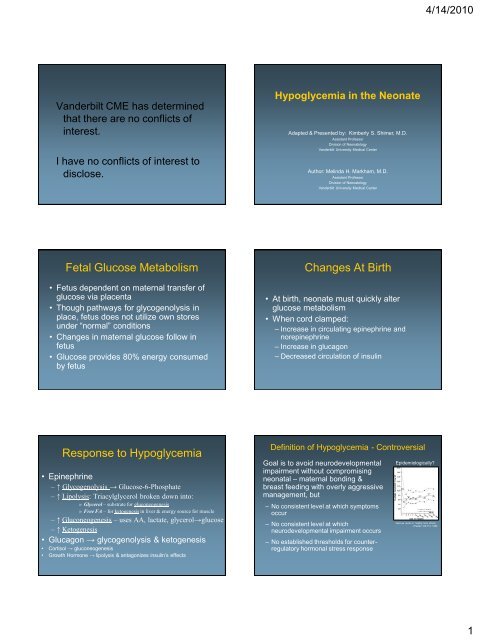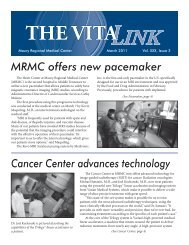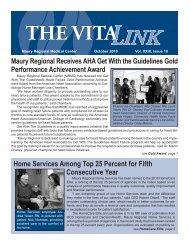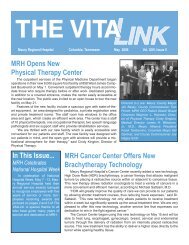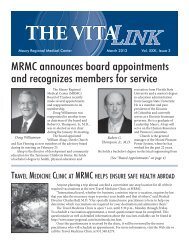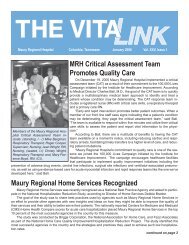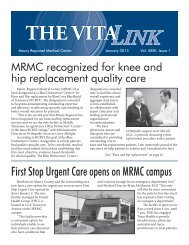Presentation pdf
Presentation pdf
Presentation pdf
Create successful ePaper yourself
Turn your PDF publications into a flip-book with our unique Google optimized e-Paper software.
4/14/2010Vanderbilt CME has determinedthat there are no conflicts ofinterest.I have no conflicts of interest todisclose.Hypoglycemia in the NeonateAdapted & Presented by: Kimberly S. Shimer, M.D.Assistant ProfessorDivision of NeonatologyVanderbilt University Medical CenterAuthor: Melinda H. Markham, M.D.Assistant ProfessorDivision of NeonatologyVanderbilt University Medical CenterFetal Glucose Metabolism• Fetus dependent on maternal transfer ofglucose via placenta• Though pathways for glycogenolysis inplace, fetus does not utilize own storesunder “normal” conditions• Changes in maternal glucose follow infetus• Glucose provides 80% energy consumedby fetusChanges At Birth• At birth, neonate must quickly alterglucose metabolism• When cord clamped:– Increase in circulating epinephrine andnorepinephrine– Increase in glucagon– Decreased circulation of insulinResponse to Hypoglycemia• Epinephrine– ↑ Glycogenolysis → Glucose-6-Phosphate– ↑ Lipolysis: Triacylglycerol broken down into:» Glycerol – substrate for gluconeogenesis» Free FA – for ketogenesis in liver & energy source for muscle– ↑ Gluconeogenesis – uses AA, lactate, glycerol→glucose– ↑ Ketogenesis• Glucagon → glycogenolysis & ketogenesis• Cortisol → gluconeogenesis• Growth Hormone → lipolysis & antagonizes insulin’s effectsDefinition of Hypoglycemia - ControversialGoal is to avoid neurodevelopmentalimpairment without compromisingneonatal – maternal bonding &breast feeding with overly aggressivemanagement, but– No consistent level at which symptomsoccur– No consistent level at whichneurodevelopmental impairment occurs– No established thresholds for counterregulatoryhormonal stress responseEpidemiologically?Glucose levels in healthy term infants.J Pediatr 109:114, 19861
4/14/2010Transient Hypoglycemia – Infantof Diabetic MotherPathophysiology of IDM– Glucose levels lower even if maternal normoglycemia• Umbilical vein BS 70% of mother’s at birth– Blunted response to hypoglycemia• evidence of persistent insulin effect that decreases thecounter regulatory hormonal response– Morbidities can be blunted with rigorous maternalglycemic controlPederson’s HypothesisComplications in IDM• Congenital anomalies• Heart failure and septal hypertrophy of heart• Hyperbilirubinemia• Hypocalcemia• Hypoglycemia• Macrosomia – may result in birth trauma• Renal vein thrombosis• Small left colon• Unexplained intrauterine demise• Polycythemia• VisceromegalyPrematurity– Low glycogen stores• Glycogen deposited mostly in last few weeks of the3 rd trimester– Inadequate fxn of & sensitivity to counterregulatory hormones in early post-natal period– Higher risk if IUGR– Late preterm infant at particular risk• Poor feeding• Expectation that baby should be doing better thanhe/she really is• Size of baby can be deceptiveIUGR Neonates– low glycogen stores• Due to low intrauterine insulin– Possible chronic hypoxia• Inefficient anaerobic glucose use– higher caloric requirements– poor feeding***All contribute to increased risk of hypoglycemia• More significant in preterm IUGR– Glycogen deposited mostly in last few weeks of the3 rd trimester• Both have inadequate fxn of & sensitivity tocounterregulatory hormones in early post-natalperiodHypoglycemia in IUGR Neonates• Very common• These babies at risk due to low glycogen stores– Primary source of glucose in the first few hours of life• With low fat stores, these neonates can’t oxidizefat for energy, either• Should check glucose levels several times in thefirst few hours of life, even in asymptomaticinfants3
4/14/2010Sepsis• Mechanism is not fully known, but likelyincludes:– Poor PO resulting in inadequate caloric intake andfaster depletion of glycogen stores– Increased metabolic rate & use of glucose– Enhanced insulin sensitivity– Decreased gluconeogenesis (G-)Perinatal Stress – Birth Asphyxia/Hypoxia• Increased use of glucose due to shift fromaerobic to anaerobic ATP production– Only get 2 ATP for each molecule of glucose• Decreased hepatic perfusion if heart failurepresent results in decreased rate ofgluconeogenesisPolycythemia & Hypothermia• Polycythemia– Increased use of glucose due to increased # RBCs.• Hypothermia– Increased glucose use required for ATP productionEtiology of Persistent or RecurrentHypoglycemiaA. Hyperinsulinism1. PHHI – Persistent Hyperinsulinemic Hypoglycemia of Infancy2. Beckwith-Wiedemann syndromeB. Endocrine disorders1. Pituitary insufficiency2. Cortisol deficiency3. Congenital glucagon deficiency4. Epinephrine deficiencyC. Inborn errors of metabolism1. Carbohydrate metabolism -- Galactosemia, hepatic glycogen storage diseases,fructose intolerance2. Amino acid metabolism -- Maple syrup urine disease, propionic acidemia ,methylmalonic acidemia, hereditary tyrosinemia, 3-hydroxy, 3-methyl glutaricacidemia, ethylmalonic-adipic aciduria, glutaric acidemia type II3. Fatty acid metabolism, defects in carnitine metabolism, acyl–coenzymedehydrogenase defectsD. Neurohypoglycemia (hypoglycorrhachia) due to defective glucose transportPHHI – Persistent HyperinsulinemicHypoglycemia of Infancy– Intractable hypoglycemia developing with in 1 stpostnatal days (2-4 days of life)– Refractory to high GIR– Severe symptoms with seizures common– Serum insulin levels will be high• 30-50% have identifiable gene abnormality, usually SUR1or Kir6.2– Focal or diffuse hyperplasia of islet cells• Subtotal or total pancreatectomy necessary– Diagnosis made by path– Keep BS >60 due to increase risk for neuro damagePHHIHussain, Seminars Fetal & Neonatal Medicine, 20054
4/14/2010Hyperinsulinism• Beckwith-Wiedemann Syndrome (Fetal overgrowth)– Large birth weight and length– Macroglossia– Malocclusion– Hypoglycemia– Omphalocoele– Ear pits or grooves– Hemihypertrophy– VisceromegalyEndocrine Disorders• Pituitary insufficiency- rare– consider in neurologic problems; look closely for signsof holoprosencephaly; midline defects;underdeveloped genitalia in males• Cortisol deficiency – CAH most common– CAH usually presents after initial discharge fromhospital; probably present before state screen results– May have virilization of females, but males will havenormal genitalia– Profound hypoglycemia– May be salt-wasting as well• Glucagon and epinephrine deficiencies -- rareInborn Errors of MetabolismIEM Associated with Hypoglycemia• Hypoglycemia associated with:– Fatty acid oxidation defects– Gluconeogenesis defects– Glycogen storage disease– Ketolytic defects– Organic acidemiasWho should be screened?• Maternal risk factors1. Intrapartum administration of glucose2. Drug treatment -- Terbutaline, ritodrine, propranolol, oral hypoglycemicagents or substance abuse3. Diabetes in pregnancy: infant of diabetic mother4. Pre-eclampsia & pregnancy induced or essential HTN5. Previous macrosomic infant• Neonatal risk factors– Preterm infants– IUGR/SGA– LGA or IDM– Poor feeders– Any signs of illness or symptoms of hypoglycemia– Hypothermia– Perinatal Stress – Birth Asphyxia or HIE– Polycythemia – ruddiness– Erythroblastosis fetalis; hydrops fetalis– Congenital cardiac malformations – murmur– Persistent Hyperinsulinemia– Endocrine Disorders – midline defects, microphallus– IEM – hepatomegalyWhen to check and what to do?• At any time when symptoms are present• For infants at risk, within the first hour oflife and repeat 1-2 more times in the first2-3 hours of life even if normal• Must be rechecked if low (
4/14/2010IVFRefractory Hypoglycemia• GIR (mg/kg/min):[Dextrose concentration (%)] X [Rate of infusion (ml/hour)][6 X weight]• Any IV bolus of D10 given must befollowed by continuous infusion of glucose• Follow glucoses (q 8-12 hours) for anybaby on IVF once euglycemia attained• Glucose levels usually very low• Baby usually symptomatic• Can increase IVF rate but likely will need centralaccess for higher dextrose concentration• Baby should be transferred• If doing hypoglycemia labs, should be drawnwhen glucose low• Can be seen in asphyxia, sepsis, or IDM; wouldworry about PHHI if GIR > 15 consistently &continued BS control issuesSummary• Hypoglycemia common in neonates• Most babies asymptomatic• Symptoms of hypoglycemia vague• Careful screening of at-risk population• Follow low glucoses closely until normalize• Treatment important due to brain’sdependency on glucoseProcedure for Consultation or Transport ofNewborn to the Vanderbilt Neonatal IntensiveCare Unit• Call 1-800-288-8111. Tell the Lifeflightoperator that you are calling about aneonatal transport or consultation.• Immediate mobilization of Angel transportteam with call, even before talking tofellow or facultyImportant Phone Numbers within theVanderbilt Neonatal Community:• LifeFlight: 1-800-288-8111• NICU: 615-322-0963• Division of Neonatology: 615-322-3476• Maternal Referrals: 615-322-2255• Maternal Fetal Medicine Consultations: 1-866-MFM-VUMC• Center for Advanced Maternal-Fetal Care: 877-338-8786• Outreach Education: 615-322-3476 or 615-322-6798• NICU Follow-up Clinic: 615-322-3475 or 1-800-288-6482• BPD Clinic: 615- 343-7617• PICU: 615-322-0928• Pediatric Emergency Room: 615-343-2996• Pediatric Referral: 615-835-7050 BeeperThank You7


